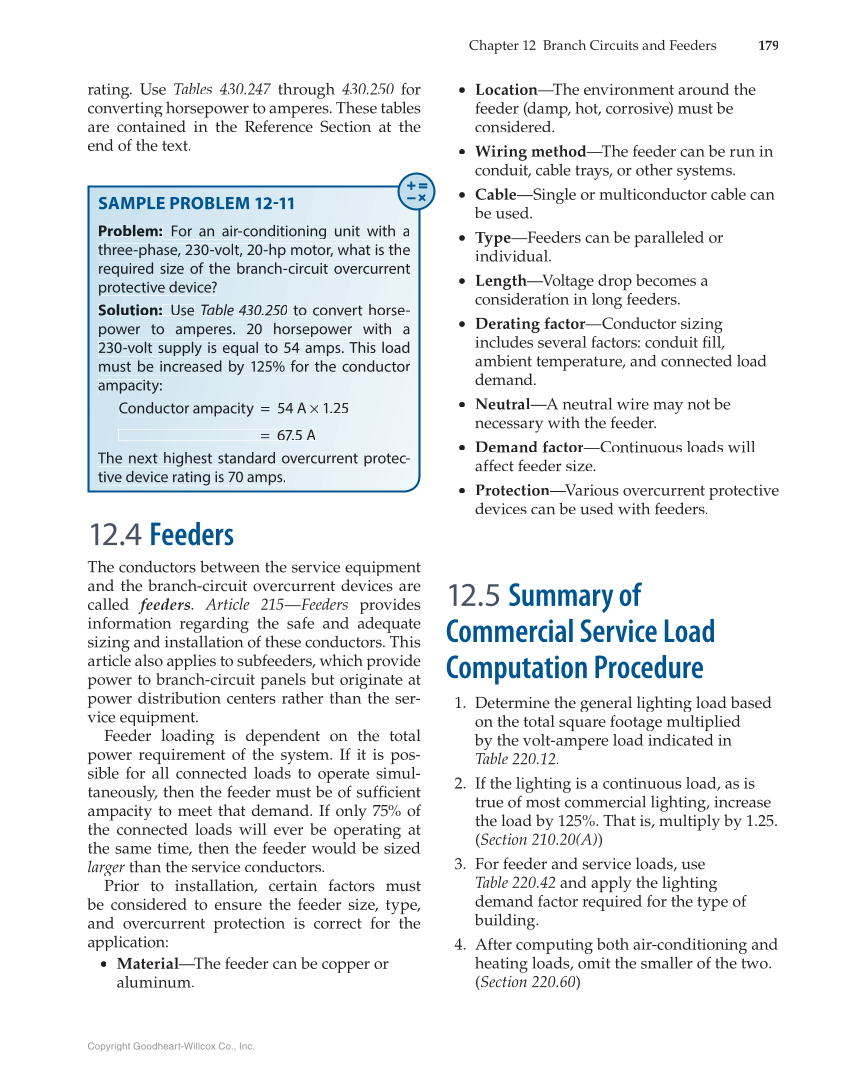Chapter 12 Branch Circuits and Feeders 179 Copyright Goodheart-Willcox Co., Inc. rating. Use Tables 430.247 through 430.250 for converting horsepower to amperes. These tables are contained in the Reference Section at the end of the text. 12.4 Feeders The conductors between the service equipment and the branch-circuit overcurrent devices are called feeders. Article 215—Feeders provides information regarding the safe and adequate sizing and installation of these conductors. This article also applies to subfeeders, which provide power to branch-circuit panels but originate at power distribution centers rather than the ser- vice equipment. Feeder loading is dependent on the total power requirement of the system. If it is pos- sible for all connected loads to operate simul- taneously, then the feeder must be of sufficient fi ampacity to meet that demand. If only 75% of the connected loads will ever be operating at the same time, then the feeder would be sized larger than the service conductors. Prior to installation, certain factors must be considered to ensure the feeder size, type, and overcurrent protection is correct for the application: • Material—The feeder can be copper or aluminum. SAMPLE PROBLEM 12-11 Problem: For an air-conditioning i unit with a a three-phase, 230-vo ol t, 20-hp motor, what is the h required size of th he branch-circuit overcurre en t protective device? ? Solution: Use Table Ta 430.250 to convert horse-o power to amperes. p 20 horsepower with wi a 230-volt supply y is equal to 54 amps. This i s load must be increased a by 125% for the con nd uctor ampacity: Conductor o ampacity = 54 A × 1.25 = 67.5 A The next highest h standard overcurre en t protec- tive device c e rating is 70 amps. • Location—The environment around the feeder (damp, hot, corrosive) must be considered. • Wiring method—The feeder can be run in conduit, cable trays, or other systems. • Cable—Single or multiconductor cable can be used. • Type—Feeders can be paralleled or individual. • Length—Voltage drop becomes a consideration in long feeders. • Derating factor—Conductor sizing includes several factors: conduit fi ll, fi ambient temperature, and connected load demand. • Neutral—A neutral wire may not be necessary with the feeder. • Demand factor—Continuous loads will affect feeder size. • Protection—Various overcurrent protective devices can be used with feeders. 12.5 Summary of Commercial Service Load Computation Procedure 1. Determine the general lighting load based on the total square footage multiplied by the volt-ampere load indicated in Table 220.12. 2. If the lighting is a continuous load, as is true of most commercial lighting, increase the load by 125%. That is, multiply by 1.25. (Section 210.20(A)) 3. For feeder and service loads, use Table 220.42 and apply the lighting demand factor required for the type of building. 4. After computing both air-conditioning and heating loads, omit the smaller of the two. (Section 220.60)
